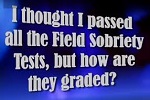
Illegal Field Sobriety Tests? What to do?
Experiences means everything. Make sure you have the correct and experienced representation for the legal issues you are faced with.
- By Attorney Richard Lombardi

A good Lawyer breaks his Fourth Amendment analysis of a DUI arrest into three distinct stages: (1) the initial stop; (2) the request that the driver submit to field sobriety tests; and (3) the arrest. 1
As discussed in previous articles, the initial stop of a motorist can be based on something as minimal as having an inoperable license plate light. So, how do officers turn a stop for a simple traffic violation into a DUI investigation?
A request to perform field sobriety tests is a greater invasion of an individual’s liberty interests than the initial stop. Therefore, such a request must be justified by Reasonable and Articulable Suspicion that the motorist is intoxicated. 2 The reasonable and articulable suspicion analysis is based on the collection of factors. 3 A police officer must weigh the totality of the circumstances to determine whether sufficient objective facts exist to create reasonable suspicion that the driver is impaired. The officer may then detain the driver long enough to confirm and/or deny his suspicions. A number of factors indicating impairment must be present before a trial court could approve the officer’s decision to conduct field sobriety tests. 4
Over time, police officers have picked up on the fact that they must include these factors in their investigative reports in order to overcome 4th Amendment challenges. As long as they use a few of these “buzz words” they can typically justify the decision to conduct field sobriety tests.
Almost without fail, nearly every DUI report I have ever read (and I’ve read a lot!) contains similar language: “I detected and odor of alcohol and observed the suspect to have bloodshot and glassy eyes.” The problem is, these factors, as well as many of the other factors listed above, are merely indicators of alcohol consumption, not alcohol impairment (some of these factors occur when there has been no alcohol consumption at all). As the Fifth District Court of Appeals recently reminded us, “The law in Ohio remains it is not illegal to consume alcohol and then operate a motor vehicle. Only if the driver’s ability to operate the vehicle is appreciably impaired . . . does a person violate the law.” 5
Research from the National Highway Traffic and Safety Administration (the agency that provides police officers with their DUI detection training) have also concluded that many of these factors are not reliable indicators of alcohol impairment.
Pursuant to NHTSA, bloodshot eyes was eliminated from the list of post stop cues an officer could reasonably rely on when assessing whether a person is impaired since bloodshot eyes could be caused by numerous factors including lack of sleep, and working the night shift. 6 Moreover, several courts have recognized that bloodshot eyes is a condition attributed to causes other than alcohol impairment (e.g. lack of sleep, cigarette smoke). 7
NHTSA has never included “glossy,” “glassy” or “glazed” eyes as one of the post stop indicators an officer could reasonably rely on when assessing alcohol impairment. The presence of Glassy or Glossy eyes was considered and evaluated, but not recommended as a reliable indicator for alcohol impairment in the final version of the DWI Detection Guide. 8 The terms: “Glassy Eyes”, “Glossy Eyes”, “Glazed Eyes” are NOT found anywhere in the NHTSA DUI Detection Manuals (both Instructor and Student Manuals).
What about the odor of an alcoholic beverage? Obviously the odor of alcoholic beverage is evidence of alcohol consumption. But, again, it is not illegal to drink and drive. As one Ohio Court put it, “The mere detection of an odor of alcohol, unaccompanied by any basis, drawn from the officer’s experience or expertise, for correlating that odor with a level of intoxication that would likely impair the subject’s driving ability, is not enough to establish that the subject was driving under the influence.” 9
No matter how much experience and training an officer may have, he does not have super powers. In 1999, NHTSA researchers conducted a study that concluded there is no statistically significant correlation between a subject’s BAC level and the strength of the odor of alcohol on the subject’s breath. 10 The officer’s estimate of BAC levels based on odor of alcohol failed to rise above random guesses. 11.
In sum, bloodshot eyes, glassy eyes, and odor of alcohol are not reliable indicators of impairment. Nevertheless, judges across Ohio accept police officers’ testimony regarding these factors to support their decision to conduct field sobriety tests. This needs to stop. The precedent needs to be challenged.

240 S. Chestnut St. Suite B. Ravenna, OH 44266
(330) 296-5252
richard.lombardi@ attorneylombardi.com
Monday-Friday: 9AM-4PM
Saturday: Closed
Sunday: Closed
While this website provides general information, it does not constitute legal advice. To schedule a free consultation with an attorney, please call or email us today.